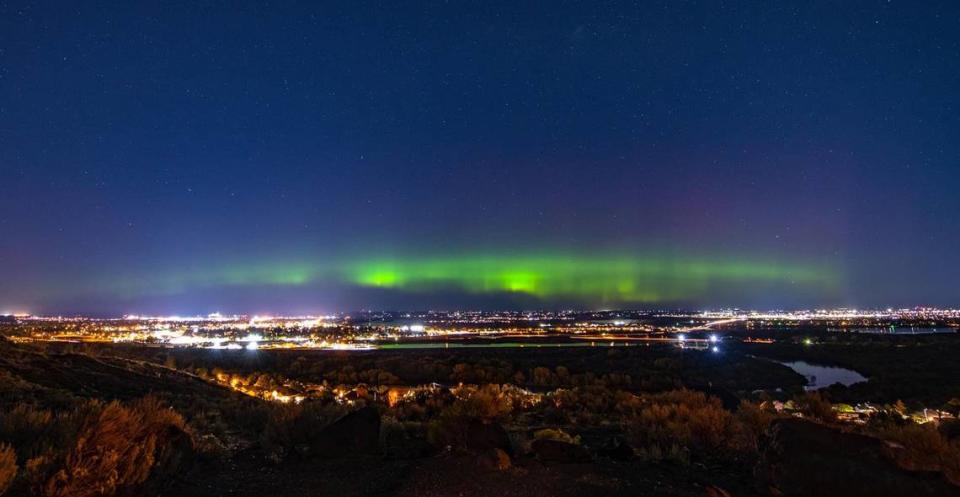Update: Northern lights forecasts keep changing. The latest on seeing them by Tri-Cities
Despite changes in predictions for seeing the northern lights this week from the Tri-Cities, residents still have a chance.
Now the forecast calls for the best chance to see the lights to be Friday or possibly Saturday night, although lights, if visible, are not likely to be as bright as originally predicted.
Initially, a bright display was expected the night of Thursday, July 13, with the Geophysical Institute at the University of Alaska at Fairbanks forecasting a Kp of 6 on the planetary K index which runs from 0 up to 9.
That would be an aurora that the National Weather Services describes as “quite bright.”
Anticipation built in the 17 states, including Washington and the northern half of Oregon, where the aurora borealis was expected to be visible.

But northern lights are difficult to predict and the institute downgraded its rating for auroral activity to a Kp of 4 early in the week and then dropped it lower and indicated that it was only likely to be dimly visible in Washington state near the Canadian border, if there.
On Thursday, NASA was forecasting the strongest chance to see the aurora borealis this week on Saturday, but has since changed that outlook to Friday night with a Kp of 5. However, the Tri-Cities may be a little far south for a good show.
The Alaska institute predicts a Kp of 4 for part of Washington, including the Tri-Cities, low on the horizon Saturday night from full dark until after midnight.
The weather appears to be good, with clear night skies forecast Friday and Saturday and not too much moonlight from a crescent moon.
Best way to see them
You will need to find a dark spot away from light pollution, preferably at one of the higher elevations in the area, if you plan to watch for a possible look at the lights.
During past solar storms there have been some reports of people seeing the northern lights at Jump Off Joe Butte just south of the Tri-Cities. Take Owens Road to reach the butte.
In 2021 the aurora borealis was faintly seen in the Tri-Cities from Richland’s Top of the World park behind Yokes Fresh Market in south Richland.
But Tri-Cities photographers known for getting some of the best photos of the northern lights stake out dark spots out in north Franklin County along Highway 260 and its nearby rural roads.
On some occasions in the past in the Tri-Cities area the northern lights appeared as a gray to pale green haze or cloudiness along the horizon. But time exposure photographs caught the event in brilliant color with bright greens and even a few streaks of pink and purple.
Tri-Cities area residents posting on social media about plans to see the northern lights have suggested finding dark spots north or east of the Hanford nuclear site, going to Lyons Ferry State Park or driving toward Dayton, Wash., on Highway 124 or Highway 12.
To find higher elevation places near the Tri-Cities, a topographic map of the greater Tri-Cities area is posted at bit.ly/Tri-CityElevations.
Maybe next year
If the northern lights are too dim to see Saturday, there should be other chances in the next year in the Tri-Cities area.
The Associated Press reports that an 11-year solar cycle that’s expected to peak in 2024 is making the lights visible in places farther to the south than where they typically are seen in Alaska, Canada and Scandinavia.
The northern lights are caused by collisions between electrically charged particles streaming out from the sun.
As the particles in the solar winds enter Earth’s atmosphere, they collide with molecules and atoms of gas, primarily oxygen and nitrogen, according to the Geophysical Institute.
Those molecules and atoms then released energy in the form of light, creating a glow in the dark sky.

